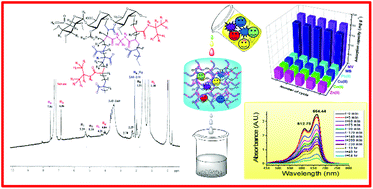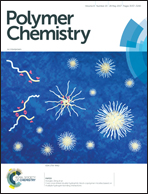Systematic synthesis of pectin-g-(sodium acrylate-co-N-isopropylacrylamide) interpenetrating polymer network for superadsorption of dyes/M(ii): determination of physicochemical changes in loaded hydrogels†
Abstract
A new interpenetrating polymer network superadsorbent (IPNS) hydrogel, possessing unprecedented physicochemical properties/swellability and excellent recyclability, has been synthesized, via solution polymerization of monomers (i.e. sodium acrylate, SA and N-isopropylacrylamide, NIPA) and natural polymers (i.e. pectin, PC), using a crosslinker (i.e. N,N′-methylenebisacrylamide, MBA) and a redox pair of initiators (i.e. potassium persulfate, PPS and sodium bisulfite, SBS), through systematic incorporation and successive optimization of different initial compositions and temperatures, for the eco-/cost-friendly mere/synergistic removal of hazardous cationic dyes (i.e. methyl violet, MV and methylene blue, MB) and/or diphenyl-azo dye (i.e. methyl orange, MO), along with the adsorptive exclusion of toxic bivalent heavy metal ions (M(II)), like Pb(II), Cu(II), Co(II) and Zn(II). The rational appearance of several physicochemical changes in IPNS networks, both loaded and/or unloaded, has systematically been characterized by FTIR, NMR, XPS, TGA, DTG, DSC, XRD, SEM, EDX, and rheological studies, along with measuring the lower critical solution temperature (LCST), gel content, % of –COOH, % graft ratio (%GR), pHPZC and network parameters of IPNS. Mere or interactive effects of structurally/chemically dissimilar dyes have comprehensively been interpreted via analyzing the monomer–dimer/dimer–trimer equilibrium, H-/J-aggregate, dye–dye complex, IPNS–dye adducts, hydrophobic interaction of alkylamino groups, orientation effect of dyes (i.e. pyramidal or propeller), azonium–ammonium equilibrium of dye etc., through extensive UV-Vis analyses, during adsorption. In addition to pseudosecond order kinetics, BET and Langmuir isotherms have also been found to be in the best agreement for MB and MV/Cu(II)/Co(II)/Zn(II)/Pb(II), respectively. In all the cases, thermodynamically feasible chemisorption processes have been found to follow the intraparticle diffusion model. The maximum adsorption capacities (ACs) of MV, MB, Pb(II), Cu(II), Co(II) and Zn(II) were obtained as 265.49, 137.43, 54.86, 53.86, 51.72 and 50.01 mg g−1, respectively, under optimum conditions.



 Please wait while we load your content...
Please wait while we load your content...